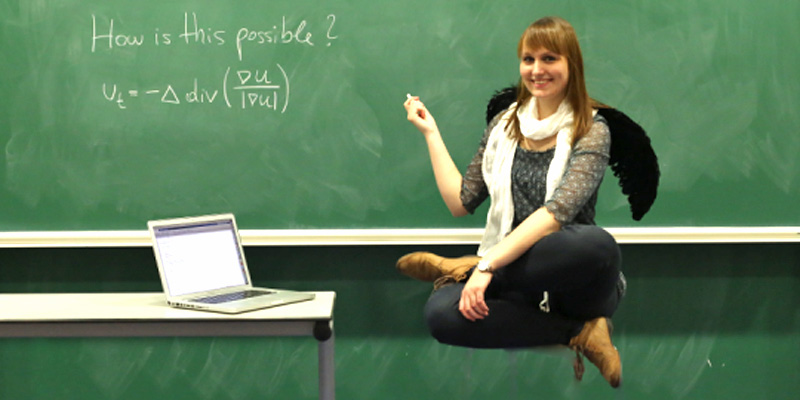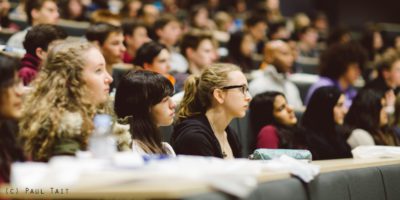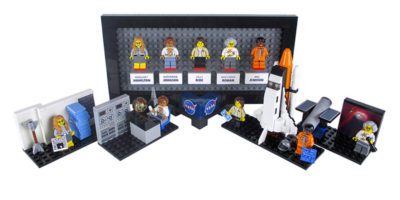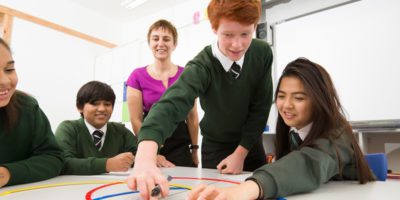Dr. Joana Grah is an applied mathematician interested in imaging and machine learning with applications in the biomedical sciences. She has recently spent time as a research associate at the Alan Turing Institute working on an interdisciplinary project aiming to develop computer-aided cancer detection tools in mammography. Joana has bachelor’s and master’s degrees in mathematics from the University of Münster in Germany and most recently secured her Doctor of Philosophy in applied mathematics from the University of Cambridge.
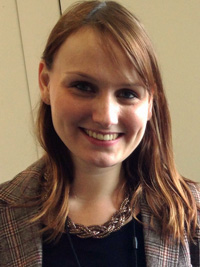
“…practice makes perfect when it comes to conference talks because you will collect positive experiences and encounters. I have hardly ever received tremendously negative feedback or unfair hostile questions…”
Studying mathematics – a gut decision
Mathematics has always been a subject that I genuinely enjoyed at school and I had some amazing and dedicated teachers who certainly influenced me in a positive way. However, the decision to study mathematics was rather made out of a gut feeling because I was also considering other fields of study.
I often ask myself how things would have turned out had I chosen something different, but I’m still more than happy with my decision and wouldn’t change anything in hindsight. My study / career path to date has been anything but straightforward though. The decision to study instead of doing an apprenticeship was already a big step, as nobody in my family had an academic background and I had no idea how life at university would be different from school, where I was always one of the best students.
Second time lucky
In my first undergraduate year I suddenly had many difficulties that meant I wasn’t able to manage the huge workload alongside my side-job and so I decided to choose mathematics a second time, and one year later I started all over again.
I still struggled from time to time but I also enjoyed my studies more and more. I was lucky enough to have a supportive and friendly environment at university. The more specialised the subjects became and the more I could choose topics in mathematics that interested me, the more my enthusiasm and curiosity grew (due to both more specialised lectures and more freedom to choose topics I liked). And still, I was always convinced that after my bachelor’s degree I wouldn’t pursue a master’s degree and after the master’s I certainly wouldn’t start a Ph.D.
Bolstering self-confidence
Ironically, the further I got in my studies, the more my self-confidence decreased. Today I know that unfortunately many people in academia, especially women in still male-dominated scientific subjects, have similar struggles, suffer from so-called imposter syndrome or even serious mental health problems.
I was fortunate enough to have incredibly supportive supervisors along my way and role models who had a significant impact on me. At the University of Münster, I took part in a mentoring programme where a couple of female students could meet up with a more senior student sharing her experience and giving advice.
That was enormously helpful and in context of this programme I attended a talk by my future Ph.D .supervisor, who shared her impressive and inspiring story, which again certainly influenced my decision to pursue a Ph.D. later on.
Research
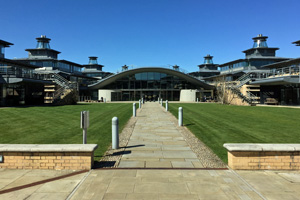
The Cambridge Image Analysis workgroup is based at the University of Cambridge within the Department of Applied Mathematics and Theoretical Physics. The head of the group is my Ph.D. supervisor, Dr. Carola-Bibiane Schönlieb, who is also director of the Cantab Capital Institute for the Mathematics of Information and the Centre for Mathematical Imaging in Healthcare.
The group works on the development and application of mathematical methods for digital image and video processing, which intersects with disciplines such as functional analysis, partial differential equations (PDEs), optimisation and many others. The common ground is often PDE or so-called variational methods, which are applied to a large variety of different fields including medicine, biology, physics, material sciences, plant sciences, forensics and arts restoration.
During my PhD, I was co-supervised by Dr. Stefanie Reichelt, head of the Light Microscopy Core Facility at the Cancer Research UK Cambridge Institute (CRUK CI), and one major project of mine was on the development of image analysis tools for phase contrast microscopy.
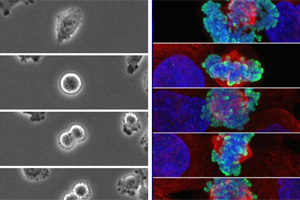
More specifically, researchers at the CRUK CI were investigating how cancer drugs affect the process of cell division called mitosis. In contrast to healthy cells, cancer cells divide much faster and hence it is desirable to find a drug that prolongs or impedes mitosis. As manual image analysis is very time-consuming and prone to error, it was crucial to find an automatic way to determine mitosis duration from image sequences of treated cell cultures.
The collaboration between us mathematicians and biologists at CRUK CI resulted in the development of a graphical user interface incorporating mathematical tools to automate the analysis.
Other Ph.D. projects of mine were concerned with sparse regularisation methods. In above-mentioned variational methods, which are for example used to reconstruct an image of a brain from measurements in magnetic resonance imaging or to restore an ancient fresco by filling in gaps where the paint has worn off, the overall aim is to minimise a functional consisting of two parts.
I also spent two months visiting Professor Guy Gilboa at the Electrical Engineering Department at the Technion – Israel Institute of Technology, in Haifa. Together with my supervisor, Dr. Carola-Bibiane Schönlieb and Dr. Martin Benning, a postdoc in the Cambridge Image Analysis group, I worked on a project examining how to learn parametrised regularisation terms that are part of the above-mentioned variational models.
Speaking and science communication – practice makes perfect
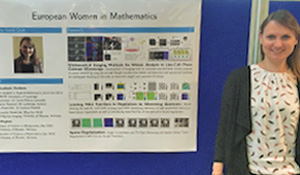
Communicating your work to colleagues in your research community is a crucial part of working in mathematics, especially during your Ph.D. It makes you visible, known and can facilitate future collaborations. I am very grateful that my Ph.D. supervisor always encouraged me to take part in summer schools, workshops and conferences, communicating my work through poster presentations, talks and discussions with other participants.
Usually a conference visit is preceded by a research paper submission or an invitation to speak. In other cases, you can just register without any obligation to present. I believe that practice makes perfect when it comes to presentations because being a good speaker or presenter is a skill that can be acquired through training.
If you are lucky enough to be able to give mock presentations to colleagues or friends – do it! The more diverse the audience, the better. A colleague working in a similar field might spot the sign error that you missed or detect the contradiction in your conclusion that you would have been otherwise pointed to in the Q&A session after your talk. Equally valuably, your mum might ask you why on earth you are working on this problem in the first place or why you are highlighting equations in yellow, which nobody will be able to see on a projector screen.
Surprisingly (and frustratingly), your voice and body language can be even more important for your presentation than your contents. If you are made aware of little flaws, you’ll be able to improve them next time.
Most importantly, practice makes perfect when it comes to conference talks because you will collect positive experiences and encounters. I have hardly ever received tremendously negative feedback or unfair hostile questions. In fact, our research community is extremely friendly and supportive.
Mentoring and outreach projects aiming to encourage more girls and women to study and work in maths
While presenting your work to your research community is essential, in my opinion, reaching out and communicating it to the general public or to potential future maths students is also very important.
My mentoring and outreach work was really motivated by my own positive experiences. As I mentioned earlier, it was very helpful for me to have a mentor during my master’s degree who was also a role model along with others, including my supervisors and researchers in our community. This is why I decided to join CyberMentor, a STEM platform for German female scientists and students. Mentor and mentee can exchange experiences and discuss through a built-in communication system.
Also, I felt it is my responsibility to reach out to school children, defy stereotypes and show them how exciting maths is. At the University of Münster, for example, I once helped to organise a girls’ day, where groups of schoolgirls visited our institute and learned about research conducted there.
Unfortunately, mathematics is still a male-dominated subject and the higher a study or career level, the fewer women are represented. This problem needs to be tackled and outreach work can help create equality.
In Cambridge, there are also a large number of outreach events taking place on a regular basis. For example, I took part in the Women in Science Festival at my college, Robinson, and I especially liked how women at various career levels could transfer their enthusiasm to the visiting students.
Only recently, the Cambridge Image Analysis group participated in the Cambridge Science Festival and organised a hands-on lab during the Faculty of Mathematics open day. It was amazing to witness how interested and curious the kids were and how much fun they had experiencing mathematical imaging in action.
Making female mathematicians more visible
We can make female mathematicians more visible exactly with outreach work and with the help of magazines likes Womanthology. I encourage every woman in mathematics to consider reaching out to others who may be in the same situation they have been in at school or at the beginning of their careers. If you can help only one woman raise her confidence, overcome doubts and pursue a career she is really passionate about it’s already worth the effort.
Here in Europe there is an association called European Women in Mathematics, which already has a large community and organises various events and activities. To make female mathematicians more visible, they launched Women of Mathematics throughout Europe with a gallery of portraits, with photographs exhibited accompanied by biographies and research descriptions of female mathematicians at different locations. The exhibition was launched in Cambridge about a year ago.
Advice to girls and women who are interested in pursuing careers in mathematics
My advice to girls and women who are interested in pursuing careers in mathematics is to talk to their teachers, supervisors or local career services and discuss different opportunities. Schoolgirls might be able to find a scheme take part in some taster university lectures. Also, I would recommend searching for mentoring programmes.
Most importantly, you should always believe in yourself, defy prejudice and follow your gut feeling. Ultimately, it is essential to be happy with and enjoy your studies and work.
Coming up
I am excited to start a postdoctoral research position at the Graz University of Technology in Austria next month and I’m looking forward to taking on this new challenge.
https://joanasarahgrah.wordpress.com/
Main image credit: This image was created by Carola-Bibiane Schönlieb, head of the Cambridge Image Analysis group, Joana Grah and Kostas Papafitsoros. The equation on the board can be solved to fill in specific parts of an image based on what’s around it, and was done numerically for this picture. The process is called inpainting.

